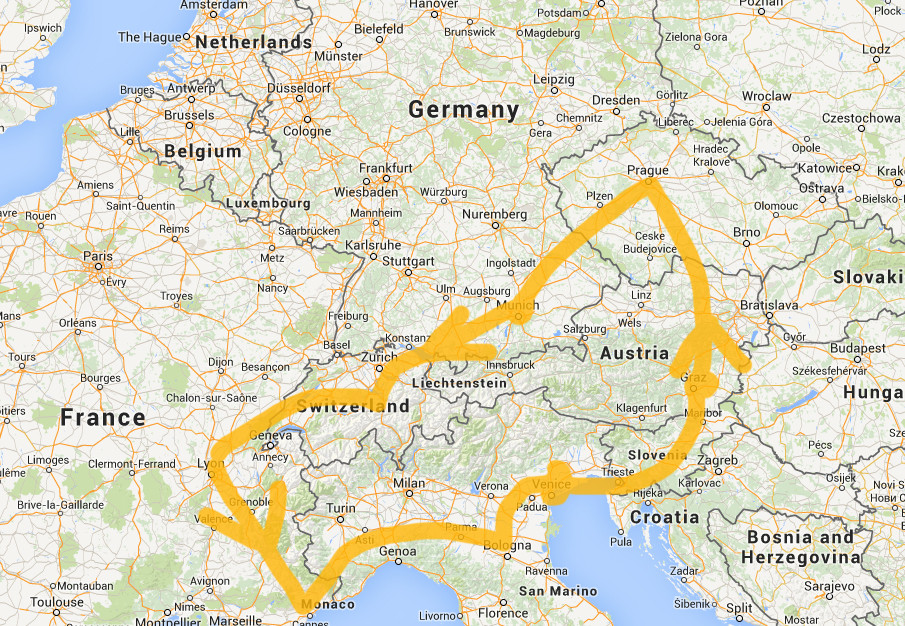QueueHammer, you're going to need a really good car for this.
Driving, for example, merely Dijon to Stockholm is an incredibly long trip on the world's best and fastest autoroutes, and also, a few thousand kilometers on Sweden's tidy but tiny roads.
So...
(1) To do this you will need a car - more on this below.
(2) Very likely a diesel because you'll save a little on the immense fuel costs, and (in short) they're better for autoroutes.
(3) For anyone actually doing this, a central point is that in France in particular, they have a very advantageous long-term car rental scheme for tourists from overseas. This is the most overwhelmingly fact if you're literally "coming from the US to drive around all of Europe"; in short it's the only realistic choice.
You'll get the sexy red "tourist plates"...

The price is a steal; do not even mention the insurance advantages, etc. It is pointless outlining the scheme here; you can google thousands of pages on it.
I recommend a Renault, as all modern cars are identical and Renault's the biggest and best represented, in general, everywhere you'll be. So: a diesel Renault.
(*) Footnote: forget the idea of "buying a car and selling it at the end". It's simply impossible with the paperwork, etc, in Europe of today. Forget it.
(*) Footnote, for the very rich, as you probably know you can buy a new BM or Benz built-to-order and collect it in Germany, have a long holiday, and they ship it stateside for you. If you're rich, phone them today and do that. Setting that aside, essentially the only choice for a long-term auto holiday in Europe is the French long-term tourist leasing deal.
(4) Where to arrive? CDG is a living hell, so fly to Lyon and get your vehicle from any Renault dealer there. The dealers there are completely familiar with the process and you'll find it astonishingly easy.
(5) You're itinerary!
Remember - don't go widdershins!
(5A) Here is your route A, which I call "All the good bits..."

So, Lyon, Monaco, Bologna, Venice, Graz, Prague, Munich, Switzerland (say, Arosa), Geneva and back to the Renault dealer in Lyon.
This will give you all the best in the world, and a few adventures, and very few boring bits.
Note that it is extremely not-that-interesting to drive from say the South of Germamy (which is utterly awesome if you love food, mountains and attractive women) to say Copenhagen (which is utterly awesome if you love food, and attractive women) ... so, "South of Germany to Copenhagen", for example, is remarkably boring and takes a long, long, long time. So itinerary A above carefully avoids all the boring bits and still gives you a "I drove all around Europe!" feel.
If you want more? Here's Itinerary B ...
(5B) Here's the baddass "I drove a very long way" route:

Fundamentally, Europe is a political entity around a very large lake (the Baltic), so do that. Roughly:
Lyon -> Bologna -> Adriatic countries -> Eastern countries to Tallinn -> Scandinavia (it's such a small word to write) -> the low countries -> Paris -> Bourdeaux -> the two different parts of Spain with Portugal in the middle -> and back to your friendly Lyon Renault dealer. (Note: although not indicated on the map, be sure to work in Bavaria (southern Germany) as much as possible when in that section.)
In short...
Lyon, Bologna, Tallinn, Lappland, Paris, Porto, Lyon.
The LBT-LPP route! So ... that's how you do it. Tips:
(*) Forget about the UK, it's not part of Europe in most touristic senses, and the food's not European.
(*) You could do this in a campervan if you're very uncool, but it costs as much anyways to park those at night.
(*) It cost me 120 euros to fill the family car last time. So in terms of "How much will it cost?" the answer is, quite simply, "an incredibly high amount of money".
(*) Be sure to take in a couple of the alpine passes ... for example
(*) Amazing tip: Amazingly there are still some car-trains in Europe. Hop a car train for the leg Hamburg-Basel for instance.
(*) You should begin and end at the same place. It's cheating if you don't. If you do not begin and end at the same place: for the rest of your life people will scoff at your achievement and say, "oh, you didn't go around in a circle, whatever dude..."
(*) Note that Europe has a few excellent restaurants. Take plenty of money for that too. Allow 200 to 2000 euros a day for this.
(*) I forgot - because Europe is enormous, you are dealing with issues like - let's say - crossing the arctic circle, as well as the aforementioned mountain passes on one of the planet's larger mountain ranges. (And I guess extreme heat in the south, if that's an issue for you.) So, the time of year you undertake this big drive, is a central issue. Cheers!
Bon Route!

 (courtesy
(courtesy 


